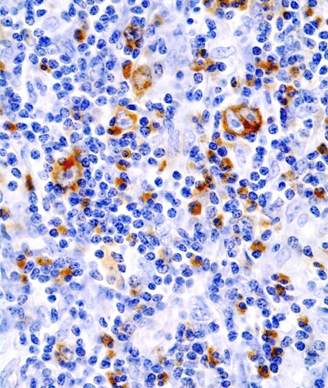Pembrolizumab/AVD Yields Sustained Responses in Classic Hodgkin Lymphoma
A larger, phase 2 trial is planned to further evaluate pembrolizumab plus doxorubicin, vinblastine, and dacarbazine in patients with newly diagnosed Hodgkin lymphoma.
"The high response rates observed at all programmed death ligand levels seen in this clinical study suggest that even low levels of programmed death ligand expression are sufficient for the response to PD-1 blockade in previously untreated classic Hodgkin lymphoma," according to the study authors.

All patients remained alive and relapse-free following treatment with sequential pembrolizumab (Keytruda) plus doxorubicin, vinblastine, and dacarbazine (AVD) for untreated, unfavorable, or advanced-stage classic Hodgkin lymphoma after long-term follow-up, according to findings from a phase 2 trial published in Blood Advances.
In total, 11 enrolled patients (36.7%) had a complete metabolic response (CMR), and a further 8 (26.7%) had a near-CMR to the initial pembrolizumab therapy. The subsequent rate of CMR after 2 cycles of AVD therapy was 100%, which persisted until the end of the study regimen. After a median follow-up of 33.1 months (range, 26.0-43.0), the rates of progression-free survival (PFS) and overall survival (OS) were both 100%. No deaths or discontinuations were reported.
Moreover, all patients had 9p24.1 alterations and PD-L1–positive disease. Depth of response did not correlate with 9p24.1 status or PD-1 pathway H-score. Depth of response to pembrolizumab, as measured by metabolic tumor volume decline, also did not correlate with disease state or Epstein-Barr virus–encoded small RNA (EBER) positivity. There was also no relationship between PD-L1 H-score and disease stage (P = .13), EBER positivity (P = .7), or 9p24.1 alteration (P = .12). In sum, 41% of patients who had a CMR or near-CMR had 9p24.1 amplification compared with 64% of those with a more than 90% reduction in metabolic tumor volume (P = .2). Investigators reported that 6 of 22 cases were EBER positive.
“In this previously untreated patient population, neither 9p24.1 alterations nor PD-L1/PD-L2 expression predicted outcomes, consistent with exquisite sensitivity to checkpoint inhibition in treatment-naïve patients,” the investigators wrote.
“We demonstrated that with prolonged follow-up, sequential pembrolizumab and AVD chemotherapy remains a highly effective strategy, with 100% of patients remaining alive without relapse. The high response rates observed at all programmed death ligand levels seen in this clinical study suggest that even low levels of programmed death ligand expression are sufficient for the response to PD-1 blockade in previously untreated classic Hodgkin lymphoma.”
This multicenter trial included a total of 30 patients who hadn’t received prior treatment and were enrolled between September 2017 and August 2019. The sequential treatment consisted of pembrolizumab for 3 cycles followed by AVD chemotherapy for 4 to 6 cycles. Adequate tissue samples for fluorescence in-situ hybridization analysis and immunohistochemistry were available in 28 and 29 patients, respectively.
The trial’s primary end point was metabolic response to single-agent pembrolizumab, assessed using Lugano 2014 criteria and, secondarily, using Lymphoma Response to Immunomodulatory Therapy Criteria. Secondary end points included incidence of PET responses according to the percent decline in metabolic tumor volume following the full treatment regimen.
The most frequent non-hematological adverse effects (AEs) were elevated liver enzymes (23.3%) and infusion reactions (16.7%). A single event of grade 4 elevated liver enzymes affected a patient during pembrolizumab therapy, which was successfully treated with corticosteroids. Additionally, a single patient experienced grade 3 Bell palsy in the setting of a viral infection, and another had grade 3 diarrhea. There were no other non-hematological AEs more severe than grade 2.
Investigators concluded by noting that the phase 2 KEYNOTE-C11 study (NCT05008224), which will assess the same regimen plus 4 further doses of consolidative pembrolizumab, will “provide more definitive evidence regarding the efficacy of this approach moving forward.”
Reference
Allen PB, Lu X, Chen Q, et al. Sequential pembrolizumab and AVD are highly effective at any PD-L1 expression level in untreated Hodgkin lymphoma. Blood Adv. 2023;7(12):2670-2676. doi:10.1182/bloodadvances.2022008116
Highlighting Insights From the Marginal Zone Lymphoma Workshop
Clinicians outline the significance of the MZL Workshop, where a gathering of international experts in the field discussed updates in the disease state.